初中英语复习总教案-初三英语复习课教案
初中英语中考复习 中考英语(人教新课标)一轮复习教案:九年级全册Unit 11-14

第30课时课题:9年级(U11-14)一、目标:1. 能运用“使役动词make ”带“去to 不定式”和形容词作“宾语补足语”的基本用法;2. 能理解“过去完成时态”的基本用法;3. 识记下列重点单词和短语:(U11)drive, examine, weight, courage, agreement, drive sb. mad, the more …the more, be friends/f riendly with sb., neither...nor …, to start/begin with, be hard on sb./be strict with sb.; (U12) backpack, ring, worker, above, alive, airport, till/until, west, market, fool, lady, officer, by the time …, give sb. a lift, in line with, show up, by the end of, sell out; (U13)bottom, coal, ugly, advantage, cost, gate, bottle, president, be harmful to, at the top of, turn off, pay for, take action, throw away, bring back; (U14) survey, row, keyboard, double, shall, ours, senior, text, manager, gentleman, congratulate, thirsty, look back at, go by, first of all, be thankful to sb., ah ead of, along with, set out二、重点:1. “动词不定式一般式to + v .”作“宾语补足语”时带不带“to ”的用法;2. 理解“过去完成时态”表示 “过去的过去”的用法:三、知识梳理:1. 词汇:(1)职业名称: 演员 主席/女主席 厨师 导演 医生 司机 农夫 actor chairman/-womancook director doctor driver farmer 领导 主人/师傅 经理 军官 物主乘客先锋 leader master manager officer owner passenger pioneer 邮递员警察/女警察总统/校长 囚犯 学生 科学家 秘书 postman policeman/-woman president prisoner pupil scientist secretary士兵 陌生人 学生 老师 侍者 工人soldierstrangerstudentteacherwaiterworker地址 机场 区域 军队 澡堂卧室建筑物addressairportareaarmybathroom bedroom building中考一轮 复习教学参考资料2. 句型与语法:(1)使役动词make的两个用法:五、巩固练习:(一)词汇练习(略)1.英汉互译下列单词:(1)职业名称:士兵老师侍者工人stranger student(2)最常用表“处所”的名词:卧室address airport area army bathroom building 首都电影院教室ceiling coast college company国家农场concert corner countryside floor gym 医院湖泊陆地图书馆heaven kitchen lab(oratory)会议博物馆办公室公园market nature palace运动场餐馆河流房间学校place pond剧院村庄世界动物园supermarket toilet university(3)表示“感觉、感情”方面的形容词:生气的兴奋的angry crazy excited glad happy interested 紧张的有病mad nice patient surprisedexamine(v.)→_____________(n.) comfortable(adj.) →_____(反义形容词) weight(n.) →_____________(v.) agree(v.) →____________________(v.) expect(v.) →____________(adj.) →_______________(反义形容词)work(n. & v.) →__________(n.) discovery(n.) →_________________(v.) alive(adj.) →________(v.) →______(-ly形式adj.) →______(-ing形式adj.) believable(adj.) →_________(v.) disappear(v.) →____________(反义词) wooden(adj.) →___________(n.) advantage(n.) →____________(反义词)scientific(adj.) →__________(n.) congratulate(v.) →______________(n.)thank(n.) →_____________(adj.) ahead(adv.) →_________________(n.)(二)语法练习1. 语法填空:(1) A: What ______(make) you angry?B: When people throw rubbish on the streets, it makes me ______(anger).C: Me, too. It takes me ______(want) to tell them clean up the streets.(2) I was made ______(cry) by sad movies.(3) _____ the time Mary ____(get) up, Tim had already gone into the bathroom.(4) ____ dinner time, I had already remembered all the news words of the class.(5) A: The river was so dirty. Even the river bottom _____(be) full of rubbish.B: But it ____(use) to be clean!A: Yes, but people _______(throw) litter(垃圾) into the river.B: So I think everyone in the town should _____(help) (to) clean up the river.(6) I ____(be) about to go to school ____ I found that I had left my homework in my bedroom.(7) As I ___________ (talk) with my classmates, I saw our math coming into the classroom.2. 将下列句子译成汉语:(1) When he put the noodles into a bowl, he realized that he had forgotten to add the green beans. __________________________________________________(2) Before she got a chance to say goodbye, he had got into the building.________________________________________________________3. 用英语回答下列问题:(1) What do you remember about Grade 7?________________________________________________________(2) What happened in Grade 8 that was special?________________________________________________________(3) What did you use to do that you don’t do now?________________________________________________________(4) How have you changed since you started junior high school?________________________________________________________(5) How do you think things will be different in senior high school?________________________________________________________(6) What are your plans for next year?________________________________________________________(7) What are you looking forward to?________________________________________________________(三)综合练习1. 听下面的独白,从每小题中所给的A、B、C三个选项中选出符合对话内容的最佳选项。
九年级英语复习教案及复习题全册
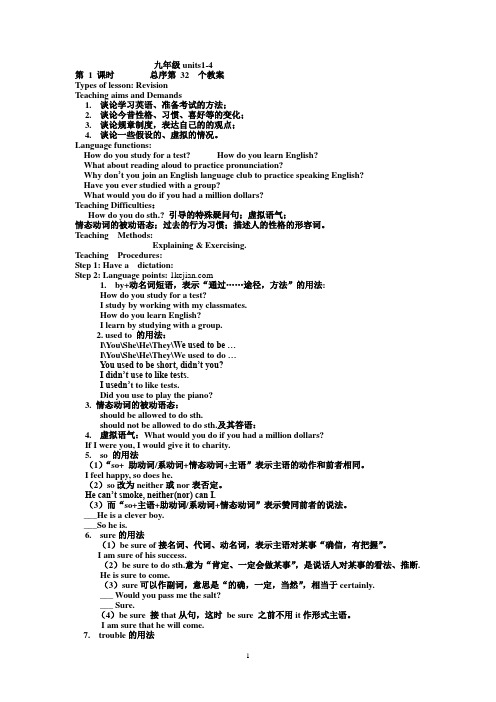
九年级units1-4第 1 课时总序第32 个教案Types of lesson: RevisionTeaching aims and Demands1.谈论学习英语、准备考试的方法;2.谈论今昔性格、习惯、喜好等的变化;3.谈论规章制度,表达自己的的观点;4.谈论一些假设的、虚拟的情况。
Language functions:How do you study for a test? How do you learn English?What about reading aloud to practice pronunciation?Why don’t you join an English language club to practice speaking English?Have you ever studied with a group?What would you do if you had a million dollars?Teaching Difficulties:How do you do sth.? 引导的特殊疑问句;虚拟语气;情态动词的被动语态;过去的行为习惯;描述人的性格的形容词。
Teaching Methods:Explaining & Exercising.Teaching Procedures:Step 1: Have a dictation:Step 2: Language points: 1.by+动名词短语,表示“通过……途径,方法”的用法:How do you study for a test?I study by working with my classmates.How do you learn English?I learn by studying with a group.2. used to 的用法:I\You\She\He\They\We used to be …I\You\She\He\They\We used to do …You used to be short, didn’t you?I didn’t use to like tests.I usedn’t to like tests.Did you use to play the piano?3. 情态动词的被动语态:should be allowed to do sth.should not be allowed to do sth.及其答语:4.虚拟语气:What would you do if you had a million dollars?If I were you, I would give it to charity.5.so 的用法(1)“so+ 助动词/系动词+情态动词+主语”表示主语的动作和前者相同。
初中英语复习教案

初中英语复习教案一、教学目标1. 知识与技能目标:通过复习,使学生掌握初中阶段英语的基本语法、词汇和句型,提高学生的英语应用能力。
2. 过程与方法目标:采用多样的复习方法,如归纳总结、对比分析、实例演练等,激发学生的学习兴趣,提高复习效果。
3. 情感态度与价值观目标:培养学生积极主动参与复习的积极性,增强学生对英语学习的信心和兴趣。
二、教学内容1. 语法复习:时态、语态、情态动词、被动语态、定语从句等基本语法知识。
2. 词汇复习:初中阶段要求掌握的词汇及相关短语。
3. 句型复习:常用句型及表达方式。
4. 功能话题复习:日常交际用语、询问信息、描述事物、表达意见等。
三、教学过程1. 导入:以一个简单的英语笑话或故事引入,激发学生的学习兴趣。
2. 复习语法:通过例句和练习,复习语法知识,引导学生进行归纳总结。
3. 复习词汇:采用闪卡、接龙等游戏方式,复习词汇及短语。
4. 复习句型:通过实例演练,使学生掌握常用句型及表达方式。
5. 复习功能话题:模拟真实场景,进行角色扮演,让学生运用所学知识进行日常交际。
6. 练习与反馈:布置适量的练习题,及时检查学生的复习效果,并进行反馈。
7. 总结与展望:对本节课的复习内容进行总结,强调重点和难点,鼓励学生继续努力。
四、教学评价1. 学生参与度:观察学生在课堂上的积极参与情况,是否主动回答问题、参与游戏等。
2. 练习正确率:检查学生练习题的正确率,了解学生的复习效果。
3. 学生反馈:收集学生的学习反馈,了解学生的学习需求和困惑。
五、教学资源1. 教材:人教版《新目标》初中英语教材。
2. 辅助材料:语法手册、词汇卡片、练习册等。
3. 多媒体设备:投影仪、电脑、音响等。
六、教学时间1课时(45分钟)七、教学建议1. 针对不同学生的学习水平,制定合理的复习计划,确保复习效果。
2. 注重培养学生的英语思维能力,引导学生运用所学知识进行实际应用。
3. 鼓励学生积极参与课堂活动,创设轻松、愉快的学习氛围。
初中英语总复习的教案模板

初中英语总复习的教案模板一、教学目标1. 知识与技能:(1)复习和巩固初中阶段所学的基本语法知识,如时态、语态、句型结构等。
(2)加强词汇、短语和固定搭配的记忆和运用。
(3)提高阅读理解能力,能够快速准确地获取文章的主要信息和细节。
(4)培养学生的写作技巧,提升写作水平。
2. 过程与方法:(1)通过讲解、练习、讨论等方式,帮助学生巩固语法知识。
(2)运用任务型教学法,提升学生的综合语言运用能力。
(3)采用分组合作、互动交流的方式,激发学生的学习兴趣和积极性。
3. 情感态度与价值观:(1)培养学生对英语学习的热情和自信心。
(2)培养学生团队合作精神,提高人际沟通能力。
二、教学内容1. 语法知识:复习时态、语态、句型结构等基本语法知识。
2. 词汇与短语:回顾和巩固初中阶段所学的重要词汇和短语。
3. 阅读理解:练习阅读各类文章,提高学生获取信息、处理信息的能力。
4. 写作技巧:总结和复习写作的基本技巧,提升学生的写作水平。
三、教学过程1. 课堂导入(5分钟)(1)教师简要回顾本节课要复习的内容,激发学生的学习兴趣。
(2)学生分享自己学习英语的心得和感悟。
2. 语法知识复习(15分钟)(1)教师通过PPT或黑板,讲解和梳理本节课要复习的语法知识。
(2)学生跟随教师一起练习语法题目,巩固所学知识。
3. 词汇与短语复习(15分钟)(1)教师挑选一些重要词汇和短语,进行讲解和示范。
(2)学生通过练习题目的方式,加强词汇和短语的记忆和运用。
4. 阅读理解训练(20分钟)(1)教师分发阅读材料,学生独立阅读。
(2)学生分享阅读心得,讨论文章的主要信息和细节。
(3)教师针对文章内容进行提问,检查学生的阅读理解能力。
5. 写作技巧训练(15分钟)(1)教师总结和复习写作的基本技巧。
(2)学生根据给定的题目,进行写作练习。
(3)学生互相评改,教师给予指导和反馈。
6. 课堂小结(5分钟)(1)教师总结本节课的复习内容,强调重点和难点。
初中复习课英语教案模板
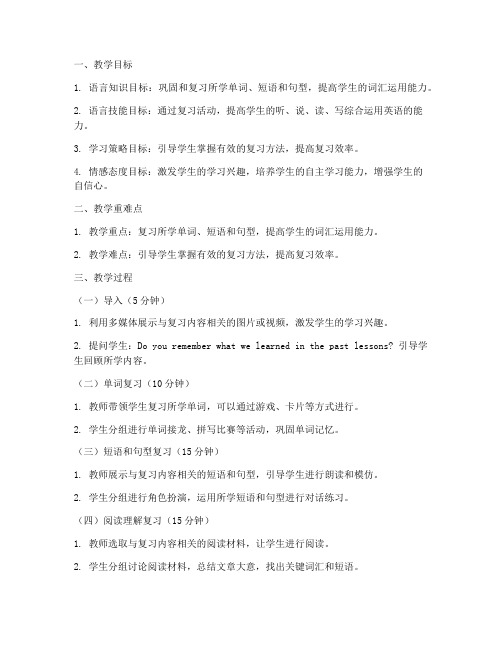
一、教学目标1. 语言知识目标:巩固和复习所学单词、短语和句型,提高学生的词汇运用能力。
2. 语言技能目标:通过复习活动,提高学生的听、说、读、写综合运用英语的能力。
3. 学习策略目标:引导学生掌握有效的复习方法,提高复习效率。
4. 情感态度目标:激发学生的学习兴趣,培养学生的自主学习能力,增强学生的自信心。
二、教学重难点1. 教学重点:复习所学单词、短语和句型,提高学生的词汇运用能力。
2. 教学难点:引导学生掌握有效的复习方法,提高复习效率。
三、教学过程(一)导入(5分钟)1. 利用多媒体展示与复习内容相关的图片或视频,激发学生的学习兴趣。
2. 提问学生:Do you remember what we learned in the past lessons? 引导学生回顾所学内容。
(二)单词复习(10分钟)1. 教师带领学生复习所学单词,可以通过游戏、卡片等方式进行。
2. 学生分组进行单词接龙、拼写比赛等活动,巩固单词记忆。
(三)短语和句型复习(15分钟)1. 教师展示与复习内容相关的短语和句型,引导学生进行朗读和模仿。
2. 学生分组进行角色扮演,运用所学短语和句型进行对话练习。
(四)阅读理解复习(15分钟)1. 教师选取与复习内容相关的阅读材料,让学生进行阅读。
2. 学生分组讨论阅读材料,总结文章大意,找出关键词汇和短语。
3. 教师针对阅读材料进行讲解,解答学生的疑问。
(五)写作复习(15分钟)1. 教师出示写作题目,引导学生进行头脑风暴,列出写作提纲。
2. 学生根据提纲进行写作,教师巡视指导。
3. 学生展示自己的写作成果,教师进行点评和修改建议。
(六)课堂小结(5分钟)1. 教师总结本节课所学内容,强调重点和难点。
2. 学生分享自己的学习心得,提出疑问。
四、作业布置1. 完成课后练习题,巩固所学知识。
2. 预习下一节课的内容,提前了解所学单词、短语和句型。
五、教学反思1. 教师应关注学生的学习效果,及时调整教学策略。
九年级英语总复习教案
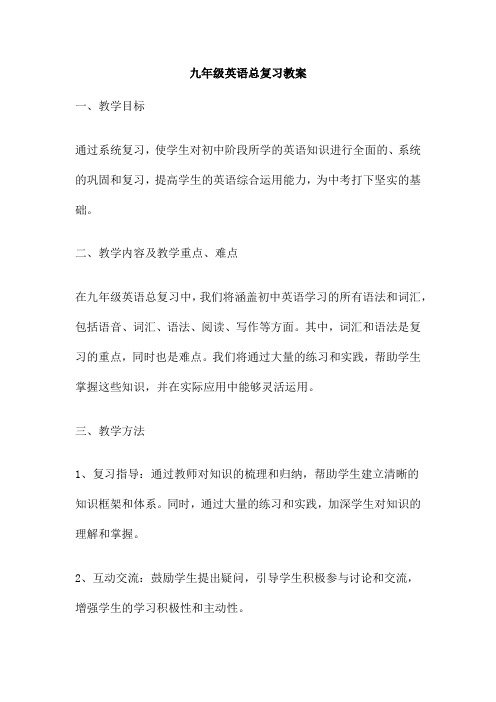
九年级英语总复习教案一、教学目标通过系统复习,使学生对初中阶段所学的英语知识进行全面的、系统的巩固和复习,提高学生的英语综合运用能力,为中考打下坚实的基础。
二、教学内容及教学重点、难点在九年级英语总复习中,我们将涵盖初中英语学习的所有语法和词汇,包括语音、词汇、语法、阅读、写作等方面。
其中,词汇和语法是复习的重点,同时也是难点。
我们将通过大量的练习和实践,帮助学生掌握这些知识,并在实际应用中能够灵活运用。
三、教学方法1、复习指导:通过教师对知识的梳理和归纳,帮助学生建立清晰的知识框架和体系。
同时,通过大量的练习和实践,加深学生对知识的理解和掌握。
2、互动交流:鼓励学生提出疑问,引导学生积极参与讨论和交流,增强学生的学习积极性和主动性。
3、测试评估:通过单元测试和综合测试,了解学生的复习效果和水平,及时调整教学策略和方法,提高复习效果。
四、教学进度安排根据中考英语科目的要求,我们将按照以下进度进行复习:1、第一轮复习:以教材为基础,全面覆盖初中英语学习的所有知识点,包括词汇、语法、阅读、写作等方面。
每周进行一个单元的复习,共计16周。
2、第二轮复习:以专题训练为主线,对重点和难点进行深入的剖析和讲解,提高学生的应试能力和技巧。
每周进行一个专题的复习,共计8周。
3、第三轮复习:以模拟考试为主要形式,进行全面的考前冲刺,提高学生的综合运用能力和应试心理素质。
每周进行一次模拟考试,共计4周。
五、教学评价及反馈机制在九年级英语总复习中,我们将建立完善的评价机制和反馈机制:1、评价机制:通过学生的课堂表现、练习完成情况、测试成绩等多个方面进行评价,全面了解学生的复习效果和水平。
2、反馈机制:对于学生在复习中出现的错误和不足之处,及时给予指导和帮助,同时调整教学策略和方法,提高复习效果。
六、教学资源及技术支持在九年级英语总复习中,我们将充分利用现有的教学资源和技术支持:1、教学资源:包括教材、练习册、模拟试卷等纸质资源,以及教学PPT、视频、音频等电子资源。
人教版英语中考总复习--宾语从句(教案)
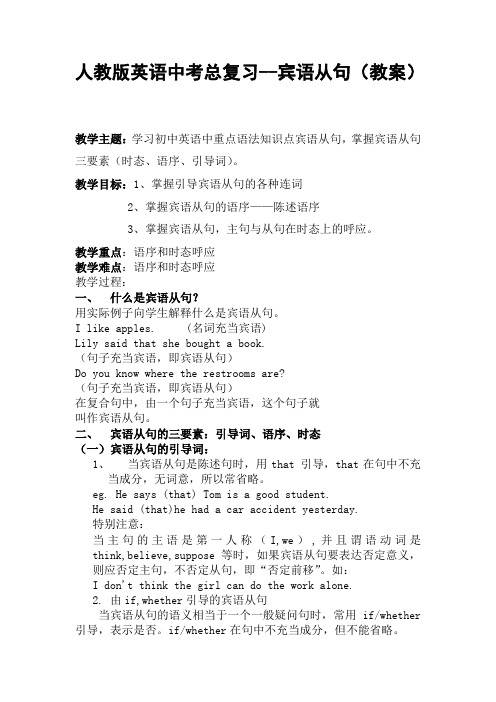
人教版英语中考总复习--宾语从句(教案)教学主题:学习初中英语中重点语法知识点宾语从句,掌握宾语从句三要素(时态、语序、引导词)。
教学目标:1、掌握引导宾语从句的各种连词2、掌握宾语从句的语序——陈述语序3、掌握宾语从句,主句与从句在时态上的呼应。
教学重点:语序和时态呼应教学难点:语序和时态呼应教学过程:一、什么是宾语从句?用实际例子向学生解释什么是宾语从句。
I like apples. (名词充当宾语)Lily said that she bought a book.(句子充当宾语,即宾语从句)Do you know where the restrooms are?(句子充当宾语,即宾语从句)在复合句中,由一个句子充当宾语,这个句子就叫作宾语从句。
二、宾语从句的三要素:引导词、语序、时态(一)宾语从句的引导词:1、当宾语从句是陈述句时,用that 引导,that在句中不充当成分,无词意,所以常省略。
eg. He says (that) Tom is a good student.He said (that)he had a car accident yesterday.特别注意:当主句的主语是第一人称(I,we),并且谓语动词是think,believe,suppose等时,如果宾语从句要表达否定意义,则应否定主句,不否定从句,即“否定前移”。
如:I don't think the girl can do the work alone.2.由if,whether引导的宾语从句当宾语从句的语义相当于一个一般疑问句时,常用if/whether 引导,表示是否。
if/whether在句中不充当成分,但不能省略。
eg. I don't know if/whether she will come here.He asked if/whether she had finished her homework.注意:一般情况下if和whether可以互换,但在以下情况只能用whether。
中考英语总复习教案
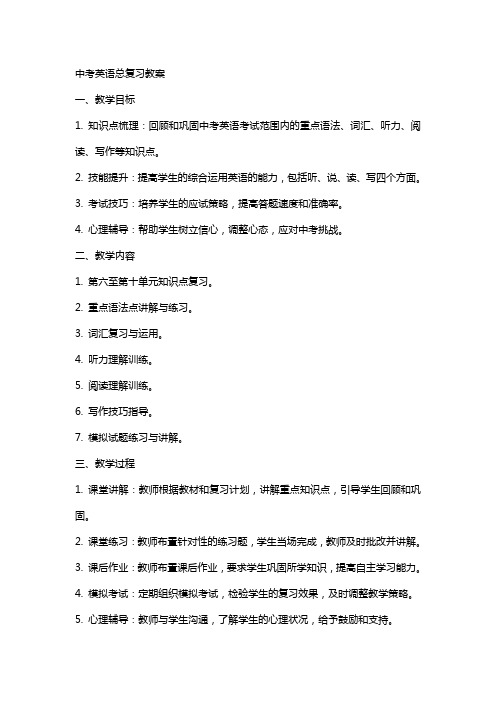
中考英语总复习教案一、教学目标1. 知识点梳理:回顾和巩固中考英语考试范围内的重点语法、词汇、听力、阅读、写作等知识点。
2. 技能提升:提高学生的综合运用英语的能力,包括听、说、读、写四个方面。
3. 考试技巧:培养学生的应试策略,提高答题速度和准确率。
4. 心理辅导:帮助学生树立信心,调整心态,应对中考挑战。
二、教学内容1. 第六至第十单元知识点复习。
2. 重点语法点讲解与练习。
3. 词汇复习与运用。
4. 听力理解训练。
5. 阅读理解训练。
6. 写作技巧指导。
7. 模拟试题练习与讲解。
三、教学过程1. 课堂讲解:教师根据教材和复习计划,讲解重点知识点,引导学生回顾和巩固。
2. 课堂练习:教师布置针对性的练习题,学生当场完成,教师及时批改并讲解。
3. 课后作业:教师布置课后作业,要求学生巩固所学知识,提高自主学习能力。
4. 模拟考试:定期组织模拟考试,检验学生的复习效果,及时调整教学策略。
5. 心理辅导:教师与学生沟通,了解学生的心理状况,给予鼓励和支持。
四、教学评价1. 课堂参与度:观察学生在课堂上的活跃程度,参与课堂提问和讨论。
2. 练习完成情况:检查学生课后练习的完成质量,及时了解学生的学习情况。
3. 模拟考试成绩:分析学生的模拟考试成绩,评估复习效果。
4. 学生反馈:收集学生的意见和建议,不断优化教学方法和内容。
五、教学资源1. 教材:人教版《初中英语教材》。
2. 教辅资料:中考英语复习资料、模拟试题、语法点讲解等。
3. 教学设备:投影仪、电脑、黑板等。
4. 网络资源:英语学习网站、在线听力、阅读材料等。
六、教学策略1. 分类讲解:将知识点进行分类,有针对性地进行讲解,使学生更好地理解和掌握。
2. 案例分析:结合实际案例,让学生更好地理解和运用知识点。
3. 互动教学:鼓励学生积极参与课堂讨论,提高课堂氛围,提高学生的学习兴趣。
4. 小组合作:组织学生进行小组合作,互相学习,互相帮助,提高学习效果。
- 1、下载文档前请自行甄别文档内容的完整性,平台不提供额外的编辑、内容补充、找答案等附加服务。
- 2、"仅部分预览"的文档,不可在线预览部分如存在完整性等问题,可反馈申请退款(可完整预览的文档不适用该条件!)。
- 3、如文档侵犯您的权益,请联系客服反馈,我们会尽快为您处理(人工客服工作时间:9:00-18:30)。
初三系列复习资料(1)名词考点集汇,讲解和训练一、名词【考点直击】1.可数名词和不可数名词的用法;2.名词所有格的构成及用法;3.近义名词的辨析。
【名师点睛】一、名词的数1.单数和复数可数名词有单数和复数两种形式。
复数形式通常是在单数形式后加词尾“-s”构成,其主要变法如下:(1)一般情况在词尾加-s,例如:book→books,girl→girls,boy→boys,pen→pens,doctor→doctors, boy→boys。
(2)以s,x,ch,sh,结尾的词加-es,例如:bus→buses,class→classes,box→boxes,watch→watches,brush→brushes。
(3)以ce, se, ze,(d)ge结尾的名词加s,例如:orange—oranges。
(4)以辅音母加y结尾的词变“y”为“i”再加-es,例如:city→cities,factory→factories, country→countries, family→families。
但要注意的是以元音字母加y结尾的名词的复数形式只加s,如:boy→boys, day→days。
(5)以o结尾的词多数都加-es。
例如:hero→heroes,potato→potatoes,tomato→tomatoes,但词末为两个元音字母的词只加-s。
例如:zoo→zoos,radio→radios,还有某些外来词也只加-s,例如:photo→photos,piano→pianos。
(6)以f或fe结尾的词,多数变f为v再加-es,例如:knife→knives,leaf→leaves, half→halves。
复数词尾s(或es)的读音方法如下表所示。
复数词尾s(或es)的读音方法情况读法例词在[p][t][k][f]等清辅音后[s] cups, hats, cakesglasses, pages, oranges, buses, watches,faces在[s][z][t][][F]等音后[iz]beds, dogs, cities, knives在[b][d][][v]等浊辅音后[z]tooth→teeth,foot→feet,child→children,mouse→mice。
【注意】与man和woman构成的合成词,其复数形式也是-men和-women。
例如:an Englishman,two Englishmen。
但German不是合成词,故复数形式为Germans;man, woman等作定语时,它的单复数以其所修饰的名词的单复数而定,如:men workers,women teachers。
有个别名词单复数一样,例如:Chinese,Japanese,sheep,deer,fish等。
但当fish表示不同种类的鱼时,可以加复数词尾。
(8)单数形式但其意为复数的名词有:people, police等。
(9)数词+名词作定语时,这个名词一般保留单数形式,中间加连字符。
例如:ten-minutes’ walk, an 8-year-old girl, a ten-mile walk。
(10)还有些名词仅有复数形式,如:trousers,clothes,chopsticks,glasses,goods,ashes,scissors,compasses。
(11)只用作单数的复数形式的名词有:科学名词:physics, mathematics/maths游戏名称:bowls专有名词:the United States, Niagara Falls其他名词:news, falls2.不可数名词“量”的表示方法在英语中,不可数名词如果要表示“量”的概念,可以用以下两种方法:(1)用much, a little, a lot of/lots of, some, any等表示多少,例如:The rich man has a lot of money.There is some milk in the bottle.Is there any water in the glass?I don't like winter because there's too much snow and ice.(2)用a piece of 这类定语,例如:a piece of paper a piece of wood a piece of breada bottle of orange a glass of water(milk) a cup of teaa cup of tea a bag of rice three bags of rice如果要表示“两杯茶”、“四张纸”这类概念时,在容器后加复数,例如:two cups of teafour pieces of paperthree glasses of water不可数名词也可用a lot of, lots of, some, any, much等来修饰。
二、名词的所有格名词所有格,用来表示人或物的所有,以及领属关系。
1. 表示有生命的名词的所有格其单数形式是加's,其复数形式是s',例如:a student's room, students' rooms, father's shoes。
2. 如其结尾不是s的复数形式仍加's,如:Children's Day。
3. 在表示时间、距离、长度、重量、价格、世界、国家等名词的所有格要用's,例如:a twenty minutes' walk,ten miles' journey,a boat's length,two pounds' weight, ten dollars' worth。
4. 无生命名词的所有格则必须用of结构,例如:a map of China,the end of this term,the capital of our country, the color of the flowers。
5. 双重所有格,例如:a friend of my father's。
【注意】如果两个名词并列,并且分别有's,则表示“分别有”,例如:John's and Mary's rooms(约翰和玛丽各有一间,共两间);Tom's and Mary's bikes(两人各自的自行车)。
两个名词并列,只有一个's,则表示“共有”,例如:John and Mary's room(约翰和玛丽共有一间);Tom and Mary's mother(即Tom与Mary是兄妹)。
【实例解析】1.(2004年上海徐汇区中考试题)These _________ have saved many children’s lives.A. woman doctorsB. women doctorC. women doctorsD. woman doctor答案:C。
该题考查的是名词作定语时的变化。
woman 作定语时要和被修饰的名词保持数的一致。
2. (2004年河北省中考试题)This is _________ bedroom. The twin sisters like it very much.A. Anne and JaneB. Anne’s and Jane’sC. Anne’s and JaneD. Anne and Jane’s答案:D。
该题考查的是并列名词的所有格。
两人共有一个房间时,只在后面的名词后加’s。
3. (2004年吉林省中考试题)---Are there any ________ on the farm?---Yes, there are some.A. horseB. duckC. chickenD. sheep答案:D。
该题考查的是特殊名词的复数形式。
从谓语动词来判断,主语应该是复数名词。
只有sheep可用作复数名词。
4. (2004年佛山市中考试题)---What would you like to drink, ________ or orange?---Orange, please.A. hamburgerB. chipC. tea答案:C。
该题考查的是名词的类别。
三种东西中只有tea能喝。
【中考演练】一. 单项填空1.--- Where have you been, Tim?--- I’ve been to ______.A. the Henry houseB. the Henry familyC. The Henry’s homeD. Hen ry’s2.In England, if ____ is in the middle of the day, the evening meal is called supper.A. foodB. lunchC. breakfastD. dinner3.You looked for it twice, but you haven’t found it. Why not try ____ .A. three timesB. a third timeC. the third timeD. once4.--- They are thirsty. Will you please give them ______ ?--- Certainly.A. some bottles of watersB. some bottles of waterC. some bottle of waterD. some bottle of waters5.Mike hurt one of his ______ in the accident yesterday.A. toothB. feetC. handD. ear6.There is some _______ on the plate.A. cakesB. meatC. potatoD. pears7.In England, the last name is the _______ .A. family nameB. middleC. given nameD. full name8.The are going to fly _______ to Beijing.A. GermenB. GermanyC. GermanysD. Germans9.The______ has two _______ .A. boys; watchesB. boy; watchC. boy; watchesD. boys; watch10.The little baby has two _______ already.A. toothB. toothsC. teethD. teeths11.What’s your _______ for being late again?A. ideaB. keyC. excuseD. news12.--- It’s dangerous here. We’d better go out quickly.--- But I think we should let _______ go out first.A. woman and childrenB. women and childC. woman and childD. women and children13.--- You can see Mr. Smith if there is a sign “_______ ”on the door of his shop.--- Thanks.A.ENTRANCEB.BUSINESS HOURSC.THIS SIDE UPD.NO SMOKING14.Are they going to have a picnic on _______ ?A. Children’s D ayB. Childrens’s DayC. Childrens DayD. Children Day15.Where are the students? Are they in _______ ?A. the Room 406B. Room 406C. the 406 RoomD. 406 Room二. 根据下列句子的情景及所给汉语注释,写出所缺单词。
